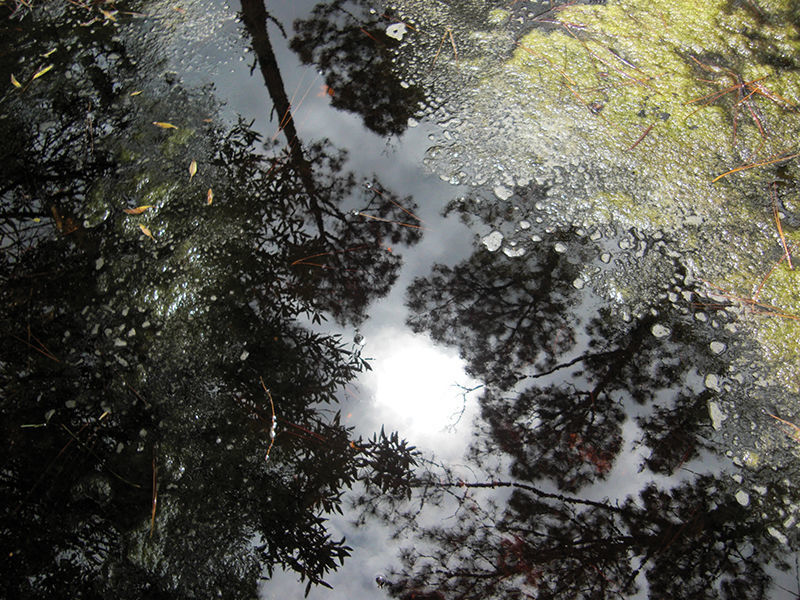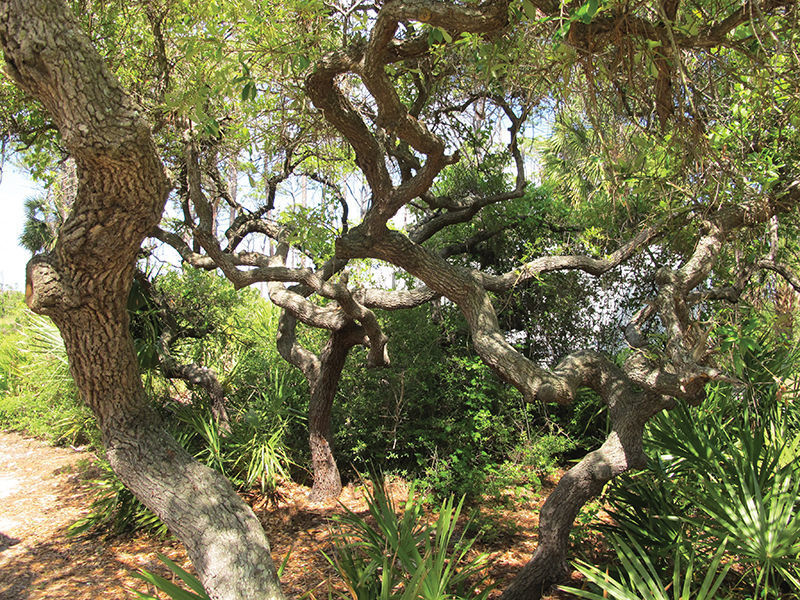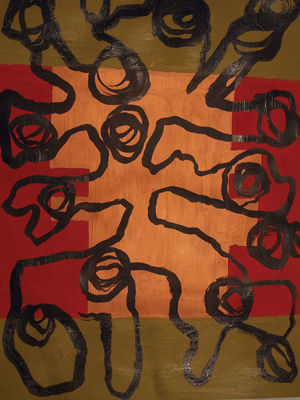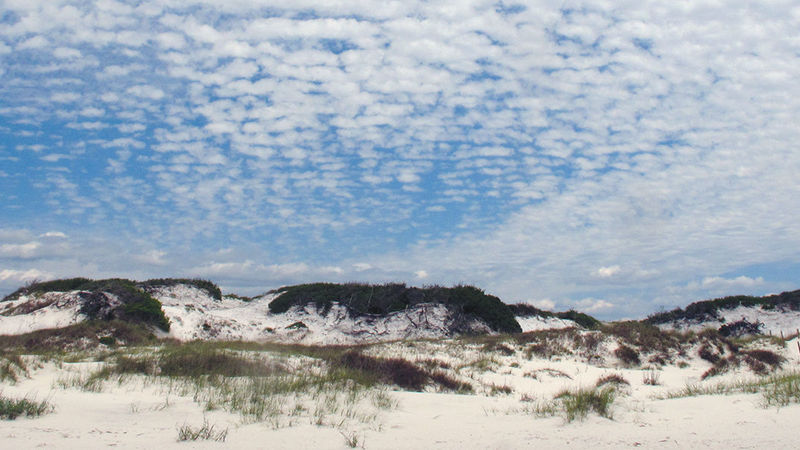Pushing down U.S. 98 to Route 30A, cutting a wedge through towering Florida Panhandle pines — 50 to 80 feet tall, looming like sentinels on both sides and sweeping up to the dimpled starry skies — almost there! Then entering St. Joe peninsula with palm trees leaning over the slender road at 45-degree angles. Warnings? Premonitions? These last remaining wilderness places in northwestern Florida are vanishing inexorably — the process of greed destroying environmental beauty and biological systems through land deals.
Driving out west on the cape is like scrawling an Arabic letter that dips south-north-west-north — a 20-mile jaunt that passes old Air Force missile silos, white sandy earth mounds resembling Aztec ceremonials and the USAF Vetro Site, bulging with state-of-the-art electronic gear and a crew that never leaves the blockhouse. And that same old Air Force pickup always parked at the locked gate. Looks like it was at Area 51 back in the ’60s. Surrounding the base is a healthy chunk of prime wilderness that should forever remain in its primordial glory. Originally, the Department of Defense owned the entire cape. Nothing here back then except a roving band of cattle . . . before that only Native Americans — an independent Seminole band that roamed 50 to 100 miles near East Bay to be murdered or bushwhacked by salesmen of trinkets.
It’s 9:30 p.m. when we arrive at our campsite — my companion for this trip is Misako Oba, an excellent Japanese photographer and an ex-CNN newsreader from Japan. Within 30 minutes the tent, chairs, bags, pillows, radios, power cords, lights and all manner of camping and art supplies are deployed, and a fire, bolstered by quartered red oak, duff and fatback, is set to burn until the early hours.
Building and maintaining a fire is an art process in which pine straw, twigs and branches serve as starters to get the red oak burning deeply in the grains and dropping a pile of red hot chunks underneath. I find a timeless pleasure in watching it grow and stirring the fire again when needed — rebuilding it like an architect as the redolent smoke drifts and lingers, the oak popping and cracking, hissing, me dropping in a dead sable palm to get a small explosion. Find red oak roots — which you never will because they are buried 6 inches or deeper in the soil — but, if you find a ball of them discarded by a bulldozer, say, scraping the earth for concrete pads to replace tent sites, well, then you get a 10-foot-diameter orange fireball that may draw unwanted attention.
These chilled nights in the late spring are excellent for stargazing and catching falling meteors in your field of view. They hang up there like infinite floral bulbs in any classic Persian carpet — mind-numbingly too many stars to properly catalog — as I stretch out. In every direction the deep textures of these stars are disconcerting. I only know such a limited number of constellations and set pieces, but out here it’s exponentially exhausting. The only option is to yield to Infinity.
This infinity business feels like a dream — my rational mind is lost, goes blank-o, can’t find meaningful connections between the star fire dots! A spider’s web or house? No, not really. More like an angelic starry universe of sun-like spheres used for a baseball-catch, with Vincent van Gogh as the umpire.
So to track time at night I usually focus on Orion’s journey, rising in the east — straddling the horizon after sunset, the three belt-stars appear first — and the great hunter leaps up to patrol the long cryptic night on this eight-mile spit of sand pushing north into the deep dark mysterioso Gulf of Mexico that touches San Blas on its south, west and northern shores. And to the east is St. Joe Bay, two to three miles wide with a distant shore, maybe a shrimper, nothing at dark — no one is out there in the solid chop and tides. This giant spit of sand and marine forest no higher than 30 feet above the sea is my wandering camp for another en plein air art project.
Cape San Blas feels like it’s my kingdom of sand — a crooked pointed finger nudging me toward eternity . . . more than a house of sand. Well, it is my art studio of sand. Sandy, trackless beaches, numberless crisscrossed forest trails and dunes, valleys galore. Suggestions of trails and an infinity of sand dunes falling into each other, pouring out to gulf sea waves and west to the “forever land” — the thin edge between sea and sky.
Thrashing tides bathed in foam piling up on the beach — sishure! swisher! I turn to take it all in — the vast never-ending grokking surging sea well. Surf noise all night, a loud continuous roar. Then a wildcat (Bobcat!) scream rings out, less than 50 yards distant, maybe the marsh edge — raw enough to convince me they are out roaming.

I have driven 400 miles over intriguing back roads and blue highways to explore Cape San Blas for my photography projects, such as the Holy Road Series, started in 2002 and still a work in progress. The Holy Road Series and Cape San Blas became connected and mutually reinforcing. I decided to vary my routes each trip to include new roads and highways and learn new landscapes. The journey to the cape and back became an important new art activity that demanded attention. The cape emerged as one of my favorite artistic spiritual hot spots where creativity blossoms, time unfolds — stretches, goes away, gets lost. And I desire a mutable quiet happening where deliberate work abounds, enforced by sensual clarity so that essential work settles the issues.
Hiking and wandering are essential work! Cape San Blas is a central hub of nature and wildlife. The unique value is its unusual positioning — surrounded by a large sea, 180 degrees of sight line, a large estuarial bay and the glittering pure sand, granularly speaking. This cape converges to create a unique and special geography where ideas, imagination and art merge and turn over and over.
This place I stumbled upon in 2002 has provided an artist’s haven for me . . . except when tornado fronts blow my tent down, like when that one loose strap failed as 50 mph winds assaulted the campsite. The freight train analogy is apt, but the front is a sharpened blade that one keeps waiting for; you’re hunkered down from the relentless rain and roaring winds, then bammo! — it hits and you feel the edge and the pressure pop as it races through the campsite. Once, two days of rain and wind brought monster surf made of turgid slate-green rollers endless and deep, with sand bars 200 yards distant. One feels a fabulous sense of isolation as if marooned, a strange sense of existing beyond the reach.
Strange to date 2002 as an official start for the Holy Road Series, my documentary film project to create a collection of Southern churches found on back roads, county roads, state highways and in towns and villages throughout Georgia, South Carolina, Alabama, Florida, Louisiana, Tennessee. I was overwhelmed. The amount of material and imagery I encountered on the road made it seem an impossible task. So in 2002, I discovered Cape San Blas on a roadmap and steered for it on the way from New Orleans to Sarasota via Grand Isle, Louisiana, where I spent the night sleeping on a beach with avid shark fishermen, bonfires ablaze while the shrimp boats worked like maniacs offshore. Most of the day I hiked this curious pirate island and floated in the warm drowsy muddy Gulf waters. The ever-present Rajun’ Cajun radio from Golden Meadow, 1600 AM, provided the background music. Found Cape San Blas late in August 2002, bodysurfed hard into banked shores with water temperature north of 80 F, got banged up in the meaty surf and sadly lost a Navajo necklace I’d bought in White Oak Canyon, Arizona, on Mother’s Day 2001 during a cross-America trip: Atlanta to Banff Arts Center in Alberta’s Rocky Mountains via Ciudad Juárez, which is contiguous with El Paso, Texas.
Anything seemed possible on that pilgrimage. Visions of the Holy Mother in a dream at a bleak Abilene rest stop at 2:00 a.m. after I slipped into the last parking spot. Transfigured clouds roiling with the sun piercsoing through at Flathead Lake, Montana, and an inner voice cries out — Mother Mary is speaking — “Start snapping pictures, Chris, there is a vision for you in those clouds; feel it now in your bones, boyo!” I took the photographs driving slowly (time seemed to lock down), with no one in sight either way, and to the right the vast Flathead Lake. I felt tears of joy gathering on my cheeks. Mother Mary was slowly inexorably bringing me into a connection with my late mother, Mary Lu Foley Kuhl, which occurred in the Bow River Valley in Banff a week after the Flathead Lake illumination. This unique invitation allowed me to join this glorious universe via my dear mother.
In this familiar site, my grove of stately storm-battered pines sways and sings in a steady offshore sea breeze. Russet tints light up their trunks and top branches as the sunlight formalities begin. I feel these pines are related by lineage through their seeds, like humans — mothers, children and cousins. I think they know me, know my patterns after staying so long here.
So San Blas became an artistic and spiritual oasis in 2002. The marsh is ever-flowing, probing into the inner reaches of the cape. Vast trail networks crisscross this primitive nature preserve. Raccoons crawl through the underbrush next to your tent every night. I track them as they scratch around on their regular sojourns, and coyotes track their food in 50-mile loops — always invisible nocturnal hunters. I did once see a large coyote, maybe five feet in length, cross in front of my car on a pitch black night as if on purpose to show himself. I spun the car 180 degrees on the empty highway, snapped on my bright lights, and el coyote vanished like a wisp of smoke along the wobbly USAF fence line headed east toward the bay. I have learned to decipher and track divergent impressions along the high tidewater lines and forest trails, picking out deer/coyote/raccoon/bobcat prints (rumors of bobcats never seen except for one at dawn, drinking from the bay with her cubs at sunrise).
I’ve encountered herds of deer in the campsite at 2 a.m. during a moonlight ramble. They appear as silent Ibsen-like ghosts frozen in my flashlight beam. When the moon is nearing fullness, the sand has a glare at night, white sand glimmering everywhere as the wind blows — the smell, my God! Sea salt, sea spores, drying grasses, hummocks, pine sap — San Blas expels an earth-scent abounding in richness, a clean elemental smell.
At night, after work and meals are completed, there is jazz by Tom Harrell, Bill Evans, Eric Alexander or even Lucky Thompson. Later the local college jazz station WPGC wails with jazz back to the 1940s. Then time to grab a book by flash- and firelight. “Look at the inner picture — it’s always there, if you miss it, you miss the world,” writes Stephen King in Duma Key, a book I took along for the ride. And later in Duma Key he wrote, “Clear communication between the selves — the surface self and the deep self — is the enemy of self-doubt. It slays confusion.” And this, too: “Go deep and take your fair salvage.”

Then finally time to submit oneself to this blessed place of wild sea surf and endless noise — all night even in sleep and dream time, too — the endless rollers trundle in from Texas or the Yucatán and smash up on the beach a mere solid 5-iron golf shot from my site. These large and rarely traversed dunes tower and shelter much wildlife. Topped by rugged red oak trees, impenetrable brambles and thickets in the draws and sea grasses and flowers, the dunes keep expanding and marching ever onward.
The next morning I’m up for a big steaming pot of Sumatra coffee and local Tupelo honey, grab a snack and pack for the beach with notebook to be scribed in, a book and a cigar before lunch, a walk and a dash in the Gulf, dry down, good for the appetite. Write whatever comes to mind — no one is in sight as the red flags rip hard in the breeze, the surf pounding, rolling in. Soon the sea turtle migration will begin, under the next full moon — all along this beach thousands of eggs laid, marked and hatched just feet away.
In this familiar site, my grove of stately storm-battered pines sways and sings in a steady offshore sea breeze. Russet tints light up their trunks and top branches as the sunlight formalities begin. I feel these pines are related by lineage through their seeds, like humans — mothers, children and cousins. I think they know me, know my patterns after staying so long here. They are cousins related over hundreds of generations in this unique marine forest surviving hurricanes and big blows many times a season, only to create a new generation pushed forth to seek the holy sun and anchor this site. Families and faces of pine bark. I’ve come to feel at home here. It quiets the mind to essential tasks, such as waking with the red orb of the sun in the dawn. A symphonic cascade of birdsong in the morn, lying on the mattress sleeping bag. Who am I? Where am I? Like Jack Kerouac awakening in a railroad hotel in Davenport, Iowa — a similar rebirth or satori.

As an artist, my roving eye is constantly searching for meaningful patterns in nature, people, architecture and design motifs — search and decode! The truth shadows these patterns. They tend to emerge if you keep observing and recording your sensations.
My first campsite — 104, where I have often worked — is graced by a 20-foot red oak tree as a screen to the north. It fascinated me. I spent hours observing tiny details and a fuller context, executing quick-time sketches and later paintings based on this single tree. It stands with Rodin-like limbs spreading out in a helter-skelter fashion. They loop back and weave themselves into a tight web of muscular oak branches that travel out in all directions but remain coiled with an immense power that was impressive yet inchoate. This pent-up energy transfixed me. I could feel it challenging me. So I got down to work in an expressionist fervor in response, turning sheet after sheet of blank white fine paper into finished paintings.
My photos on San Blas serve as a memory bank as I am drawn to search out these red oak giants on my hikes through the primitive area on the Air Force base in order to study and document their growth patterns and to seek out pure beauty in this land. The still camera images that serve my studio work pile up.
So when I am on San Blas time, I chuck my cell phone away and submit to this place. It’s absolutely simple. Walking the shroud-misted shoreline in and out of ancient cypress trees and hardwood emerging from the wet sand and surf like sentinel monsters guarding their redoubt. Time stands still, waves crash in on me as I spy the forests beyond. San Blas is like a war zone — all the pines’ lower branches sheared away by past storms. Only the top boughs survive, like semicircular rosettes or upside-down mushroom tops. Walking three minutes to the beach, billions of stars glimmer, moon or no moon; one gauges it all in a glance.
Dive into the art, losing the sense of time. It stops. A block of three to four hours melts away. I feel flushed and joyful as the artwork progresses — success achieved in welding an amorphous image of swirling transparent color tones into a finished work. Now 10 paintings are drying in the sun on the sand in the shade.
I work for five or six hours. The heat gathers. I walk back to the beach to read, think, daydream and plan the rest of the day. Later to eat, refresh, rest and read some more before watching the sunset and its afterglow — a mirage of saffron yellow, transparent orange, deeper magenta strengthens, and then the sky fades to dusky purples and the darkling night. Orion crawls up the eastern sky and I set the fire going until the wee hours, red oak crackling, snapping and popping away. I head to the beach to watch the stars emerge — walk in inky blackness. Drift off to sleep with visions of loved ones and paintings to come, hikes dreamed up for the next day . . . and the fire pops all night as I watch the liquid stars drift and fall into the arms of Morpheus.
The tough, dreamy and exhausting contours and context that this unique peninsula provides are ever diminishing. One is forced now to search deeper in the wilderness to find it, really. These wild untamed conditions can be tough places sometimes. Submitting oneself is essential to experience the promise of every day. The results pay off — in putting body and soul into one piece. Recharging the soul’s batteries and unleashing the creative effort to produce more works of art.
I always feel my life start over here — starts new: open, fresh, eager for life, friends, work, art, creation, yes, yes. That is the big deep thrust; my heart grows large by some spiritual courage, power.
Heart and soul open to the creator for his infinite gifts and mercy.
AHO!
Christopher Kuhl is a visual artist and writer whose home base might be Atlanta.
